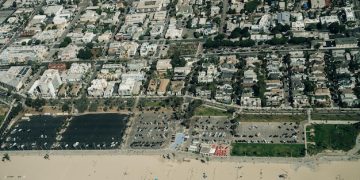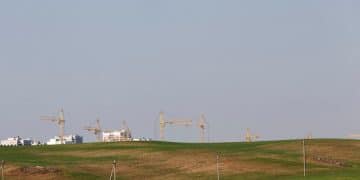Decoding Extreme Weather: US Trends & 5-Year Forecast
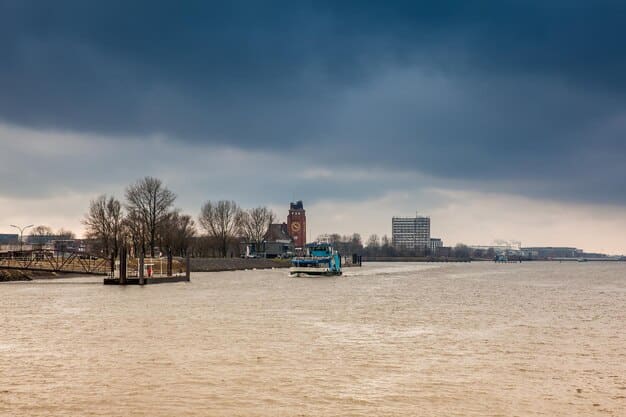
Decoding the Science Behind the Recent Increase in Extreme Weather Events Across the US: What Can We Expect in the Next 5 Years? explores the scientific drivers of escalating extreme weather events in the United States, offering insights into anticipated trends and potential future impacts over the next five years.
The United States has been grappling with an alarming surge in extreme weather events, from devastating hurricanes to unprecedented heatwaves. Decoding the Science Behind the Recent Increase in Extreme Weather Events Across the US: What Can We Expect in the Next 5 Years? is crucial to comprehending what’s driving these shifts and what the immediate future holds.
Understanding the Surge in Extreme Weather Events
Extreme weather events are becoming increasingly frequent and intense across the United States. These events, encompassing everything from severe storms and floods to droughts and heatwaves, are significantly impacting communities, infrastructure, and ecosystems. In order to grasp the full extent of the issue, it is imperative to examine the underlying factors and patterns contributing to this phenomenon.
Defining Extreme Weather
Extreme weather refers to unusual, severe, or unseasonal weather conditions that are at the edge of the historical distribution. This can include record-breaking temperatures, torrential rainfall, prolonged droughts, and unusually strong storms. These events often exceed the coping capacity of local ecosystems and communities.
Observed Trends in the US
Over the past few decades, the US has witnessed a clear uptick in extreme weather. The National Climate Assessment reports that the intensity and frequency of heatwaves have risen, cold waves are becoming less frequent, and precipitation patterns are shifting, leading to more intense rainfall events in some regions and prolonged droughts in others. Coastal areas are also facing increased flooding due to rising sea levels and more powerful storms.
- Increased Heatwaves: Rising average temperatures are causing more frequent and intense heatwaves, posing significant health risks, especially for vulnerable populations.
- Intensified Storms: Warmer ocean temperatures fuel more powerful hurricanes and cyclones, leading to greater destruction along coastal regions.
- Severe Flooding: Changes in precipitation patterns result in more intense rainfall episodes, leading to increased flooding in urban and rural areas.
- Prolonged Droughts: Many parts of the US are experiencing longer and more severe droughts, impacting agriculture, water resources, and ecosystems.
The escalating frequency and intensity of extreme weather events in the US demand a comprehensive understanding of the underlying causes and contributing factors. Addressing these challenges requires a concerted effort involving scientific research, policy interventions, and community resilience initiatives.
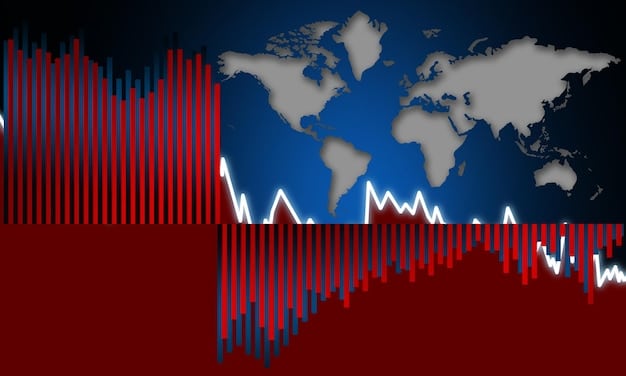
The Science Behind Extreme Weather: Climate Change Connection
The scientific community overwhelmingly agrees that climate change is a significant driver behind the increase in extreme weather events. While natural variability plays a role, human activities, particularly the emission of greenhouse gases, have amplified these events. Understanding the intricate relationship between climate change and extreme weather is crucial for effective mitigation and adaptation strategies.
Role of Greenhouse Gases
Greenhouse gases, such as carbon dioxide and methane, trap heat in the Earth’s atmosphere, leading to global warming. This warming has far-reaching effects on weather patterns, ocean temperatures, and the hydrological cycle. The accumulation of these gases from burning fossil fuels, deforestation, and industrial processes is the primary driver of climate change.
Impact on Temperature and Precipitation
Climate change is causing a rise in average temperatures worldwide. This increase in temperature leads to more frequent and intense heatwaves. Additionally, warmer air holds more moisture, resulting in heavier rainfall and increased risk of flooding. The shifting temperature gradients also disrupt atmospheric circulation, impacting storm tracks and intensity.
Changes in Atmospheric Circulation
Climate change alters atmospheric circulation patterns, affecting weather systems globally. The jet stream, a high-altitude wind current that influences weather patterns, is becoming more erratic, leading to prolonged periods of extreme weather in specific regions. Changes in ocean currents, such as the Gulf Stream, further contribute to these disruptions.
The connection between climate change and extreme weather is complex and multifaceted. By understanding the science behind this relationship, policymakers, scientists, and communities can take proactive steps to mitigate the impacts of climate change and build resilience to extreme weather events.
Specific Extreme Weather Events and Their Mechanisms
Different types of extreme weather events exhibit unique mechanisms and are influenced by climate change in distinct ways. Examining specific events, such as hurricanes, heatwaves, and droughts, provides a deeper understanding of the processes at play.
Hurricanes and Rising Sea Temperatures
Hurricanes are fueled by warm ocean waters. As sea temperatures rise due to climate change, hurricanes can become more intense, with higher wind speeds and heavier rainfall. Rising sea levels also exacerbate the impacts of storm surges, leading to more extensive coastal flooding.
Heatwaves and Climate Patterns
Heatwaves are becoming more frequent, longer, and hotter due to rising average temperatures. Changes in atmospheric circulation patterns, such as high-pressure systems that trap warm air, contribute to the severity of these events. Urban heat islands further amplify the impacts of heatwaves in cities.
Droughts and Changes in Precipitation
Climate change is altering precipitation patterns, leading to more prolonged and severe droughts in certain regions. Warmer temperatures increase evaporation rates, drying out soils and vegetation. Changes in atmospheric circulation can also shift storm tracks away from drought-prone areas.
- Rising Sea Temperatures: Warmer ocean waters intensify hurricanes.
- Atmospheric Patterns: High-pressure systems exacerbate heatwaves.
- Altered Precipitation: Changes in rainfall patterns lead to droughts.
Understanding the specific mechanisms driving these extreme weather events is critical for developing targeted mitigation and adaptation strategies. By focusing on the unique characteristics of each type of event, communities can better prepare for and respond to the impacts of climate change.
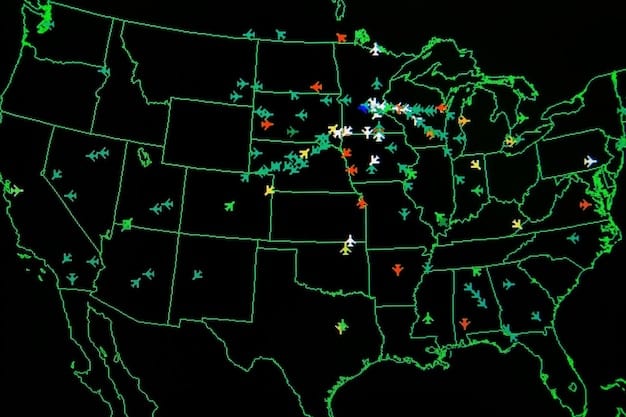
Forecasting the Next 5 Years: Predictions and Models
Predicting the future of extreme weather events requires advanced climate models and forecasting techniques. Scientists are using these tools to project trends over the next five years, providing valuable information for policymakers and communities to prepare for what lies ahead.
Climate Models and Projections
Climate models are complex computer simulations that use mathematical equations to represent the Earth’s climate system. These models incorporate data on atmospheric conditions, ocean temperatures, and land surface processes to project future climate scenarios. While models have limitations, they provide valuable insights into potential future trends.
Expected Trends in the US
Current climate models suggest that extreme weather events will continue to increase in frequency and intensity over the next five years. The National Climate Assessment projects further increases in heatwaves, heavy rainfall events, and coastal flooding. Droughts are expected to become more severe in some regions, while others may experience more frequent and intense storms.
Based on current projections, the following trends are anticipated:
- Increased Heatwaves: More frequent and intense heatwaves, particularly in urban areas.
- Heavier Rainfall: Greater precipitation in many regions, leading to increased flooding risks.
- Coastal Flooding: Rising sea levels and powerful storms intensifying coastal flooding.
- Severe Droughts: Prolonged and more severe droughts impacting agriculture and water resources.
While these models provide valuable projections, it is important to recognize that the future is not set in stone. Aggressive mitigation efforts to reduce greenhouse gas emissions could significantly alter these trends and lessen the severity of future extreme weather events.
Impacts on Infrastructure and Communities
Extreme weather events pose significant threats to infrastructure and communities across the United States. These events can disrupt essential services, damage property, and displace populations. Understanding the scope of these impacts is crucial for developing resilience and adaptation strategies.
Damage to Infrastructure
Extreme weather can cause widespread damage to critical infrastructure, including transportation networks, energy grids, and water systems. Flooding can inundate roads and bridges, disrupting transportation routes. High winds can topple power lines, leading to widespread outages. Droughts can strain water resources, impacting agricultural production and municipal water supplies.
Displacement of Populations
Severe storms, floods, and wildfires can force people to evacuate their homes, leading to temporary or permanent displacement. Displacement can strain local resources and disrupt social networks. In extreme cases, entire communities may need to relocate due to the impacts of climate change.
Economic Costs
The economic costs of extreme weather events are staggering. Damage to infrastructure, lost productivity, and emergency response efforts can cost billions of dollars annually. The National Oceanic and Atmospheric Administration (NOAA) tracks billion-dollar weather and climate disasters, and the number of these events has been steadily increasing in recent years.
Addressing these impacts requires a comprehensive approach that includes investments in infrastructure resilience, community preparedness programs, and policies that promote sustainable development. By taking proactive steps, communities can reduce their vulnerability to extreme weather events and protect the well-being of their residents.
Building Resilience and Adaptation Strategies
Given the increasing frequency and intensity of extreme weather events, it is essential to develop strategies to build resilience and adapt to the changing climate. These strategies can help communities reduce their vulnerability to extreme weather and protect lives and property.
Infrastructure Improvements
Upgrading infrastructure to withstand extreme weather is a critical adaptation strategy. This can include reinforcing bridges and roads, elevating homes and businesses in flood-prone areas, and strengthening power grids to withstand high winds. Green infrastructure, such as wetlands and urban trees, can also play a role in reducing flood risks and mitigating the impacts of heatwaves.
Community Preparedness Programs
Community preparedness programs can help residents prepare for and respond to extreme weather events. These programs can provide education on emergency planning, evacuation procedures, and disaster relief resources. Engaging community members in preparedness efforts can foster a sense of collective responsibility and improve resilience.
Policy and Planning Measures
Government policies and land-use planning can also play a role in building resilience. Zoning regulations can restrict development in high-risk areas, such as floodplains and coastal zones. Building codes can require new construction to meet higher standards for wind resistance and flood protection. Policies that promote sustainable land management and reduce greenhouse gas emissions can also contribute to long-term resilience.
By implementing a combination of infrastructure improvements, community preparedness programs, and policy measures, communities can enhance their resilience to extreme weather events and protect themselves from the impacts of climate change.
| Key Point | Brief Description |
|---|---|
| 🔥 Rising Temperatures | Heatwaves becoming more frequent and intense across the US. |
| 🌊 Coastal Flooding | Sea levels rising, leading to more frequent and severe coastal flooding. |
| 🌧️ Extreme Rainfall | Increased precipitation, causing more intense and frequent flooding events. |
| 🌵 Prolonged Droughts | Many regions experiencing longer, harsher droughts impacting water resources. |
Frequently Asked Questions
▼
The primary driver is climate change, largely due to increased greenhouse gas emissions. These emissions lead to rising temperatures and altered weather patterns, contributing to more frequent and intense extreme weather.
▼
Rising sea temperatures provide more energy for hurricanes, allowing them to become stronger with higher wind speeds and heavier rainfall. This also increases the risk of significant coastal flooding as storm surges intensify.
▼
Extreme weather can lead to significant damage to infrastructure, including roads, bridges, power grids, and water systems. This can disrupt essential services, displace populations, and result in substantial economic costs.
▼
Communities can invest in infrastructure improvements, such as reinforcing buildings and elevating structures in flood-prone areas. Developing community preparedness programs and implementing sustainable land-use policies are also effective strategies.
▼
Climate models provide valuable insights into potential future trends, but they have limitations. While not perfect, they help project long-term changes. Continuous refinement and validation of models enhance their accuracy in forecasting extreme weather.
Conclusion
In summary, the surge in extreme weather events across the US is deeply connected to climate change, with projections indicating a continued increase in frequency and intensity over the next five years. Addressing this challenge requires a multifaceted approach, including reducing greenhouse gas emissions, investing in resilient infrastructure, and enhancing community preparedness.
